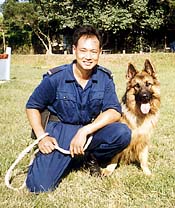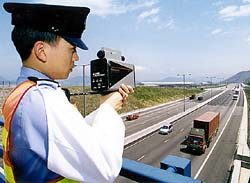



















- Rocky gives his life | |
 Pal and partner: PC Hung and Rocky pause for a photo back in their training days at the Police Dog Unit.
|
FEW things can be more devastating than
losing your partner.
But for Police Constable Hung Ping of the Police Dog Unit (PDU), Rocky, the two-year-old German Shepherd he handled, was friend and family. Rocky died on duty while chasing a man acting suspiciously in a corridor of Lok Man Sun Chuen, Ho Man Tin, on March 30. Rocky and PC Hung gave chase when the suspect fled. Rocky was killed when he fell from the building. The suspect escaped. The weeks since the incident have been a distressing time for PC Hung with sleepless nights and loss of appetite. "Rocky was the best partner I have ever had. He was absolutely loyal, true to his partner, full of energy and loved to work. We had developed a tacit and mutual understanding in the last few months. I feel fortunate to have worked with him, no matter how short the period may have been," PC Hung said. "I once told my four-year-old daughter that Rocky was her brother and she liked him so much. We took him out on holidays and we had a lot of fun." Such comradeship is not born overnight. Rocky was donated to the PDU in October last year by a member of the public, and started patrolling on March 1 in Kowloon City Division upon completion of intensive training. Rocky and PC Hung were top of their class in training. Inspector PDU Chan Man-wing said it was not unusual for the public to donate pups to the unit. |
|
"But we have to check whether they are suitable for performing the duties of police dogs like searching, chasing and attacking suspects," Mr Chan said. "Rocky possessed the character of a capable police dog, able to listen to commands and work well with his partner." When a police dog and handler are assigned as a pair, they are bound to work together until the dog retires, forming a very close relationship. Apart from their ordinary duties, handlers are responsible for feeding, cleaning and taking general care of their partners. Despite his sadness, PC Hung remembers the days with Rocky with a smile. "Don't be misled by the size of his body, Rocky was like a child and was very gentle and caring - he always wanted you to play with him. But when he worked, he became very alert and enthusiastic. I treasure the days when we were together," he said. "I remember once when we were patrolling along Ma Tau Wai Road where there are lots of restaurants. Rocky gave me a wink and looked at the food stalls. All of a sudden I realised that his mouth was watering because of the smell of the food. But as he was a well-trained working dog, we just kept on patrolling. Sometimes I would bring his favourite snack and give him a treat after a long day's work. He realised that and would never complain while he was working." PC Hung said he now concentrates on his duties taking care of pups at PDU and hopes he will be given a new partner very soon. "I will never forget Rocky, but I am confident I will work with my new partner with the same enthusiasm as I did with him." | |
| CRIMINAL
investigators are set for a boost in prosecution power with the help of a regular advisory bulletin
gathered from the experiences of other officers.
The first Criminal Prosecutions Bulletin, published in January, has proven so popular the document will run quarterly and also offer advice to officers over the Internet at the touch of a button. Prepared by Chief Inspector Richard Skinner and Senior Inspector Richard Farrar of the Regional Intelligance Unit/Hong Kong Island, the bulletins provide information on significant criminal prosecutions and investigations, passing on the first-hand experience gained by the officers involved in the cases. |
 CIP Richard Skinner displays the new quarterly Criminal Prosecutions Bulletin prepared by RIU HKI |
|
Mr Skinner said the bilingual publication would better educate less-experienced officers of criminal procedures and help avoid cases being acquitted in court due to technical breeches. He said the bulletins would also include some investigations which may not have resulted in a prosecution, but still presented important lessons for investigators. It also covers successful prosecutions made as a result of a specific police action. "The bulletin looks at such cases and breaks them down into points, avoids the legal jargon and is more user-friendly - it has a lot more practical applications," Mr Skinner said. "It looks at cases and whether there are any lessons to be learned from them. It is an advisory service to officers to increase their knowledge base, and the idea is to make it readily available to them. "Quite a number of officers have read it and we have had favourable comments and feedback so far which shows it is a worthwhile initiative which could be expanded even further." Mr Skinner said the second issue was being finalised and should be available by early May. He said future issues could see colour graphics being used to "jazz-up" the documents' appearance and make technical points more understandable. "At the moment it is just a text document and a bit of a dry-read. We want to make it a bit more eye-grabbing, more jazzy, with graphics which can help explain some of the situations it discusses," Mr Skinner said. The bulletin was based on a similar one produced by Kowloon East police which looked more at general policing, rather than criminal prosecutions. "If we can further improve the professionalism of our officers then we can be of even better service to the public," Mr Skinner said. | |
 Eagle eye: Non-stop surveillance keeps offences and accidents down on the link to the new airport |
SINCE the Lantau Link and North Lantau
Expressway opening, the number of accidents on the sole route to the airport has remained low.
This is due to not only clear road signs and the modern design of the highway, but also the special team from Enforcement and Control/Traffic/New Territories South who patrol the 21-kilometre route 24 hours a day. Chief Inspector/Support/E&C/T/NTS Mark Dyson said the route was manned by over 30 officers performing the effective "High Profile Patrolling" technique. "In other words, police officers are seen clearly by road users while they are patrolling the route," Mr Dyson said. |
|
"During each 24-hour period, no fewer than four laser gun operations are conducted along the route, aimed at detering speeding." Ensuring a clear route to the airport was of utmost importance, he said. Most offences so far were speeding and failure to keep left. From July 1998 to the end of March this year, there were 3,260 cases of speeding and 2,926 cases of failing to keep left. "We have been very successful in preventing accidents and there have been no major closures on the route. "Our strategy is to make people drive very carefully, by being aware of the police presence," Mr Dyson said. However, officers have also had to keep a watchful eye on potential offenders from the opposite end of the speed spectrum - the cattle which roam down from the Lantau hills. "When it first opened, there were a number of occasions when cows were approaching the highway and officers had to use their motorbikes like cowboys to chase them away. "Now the situation has been improved because more fences have been erected and cattle grids installed," Mr Dyson said. | |

![]()
